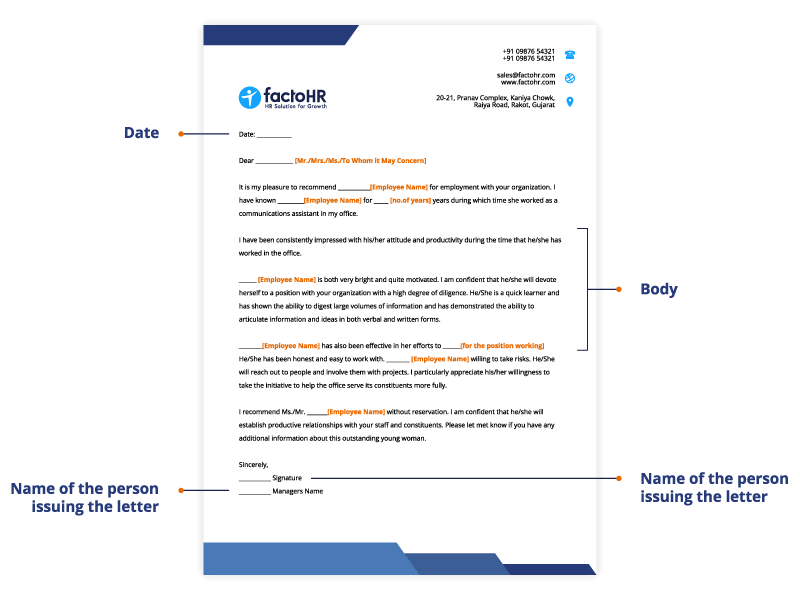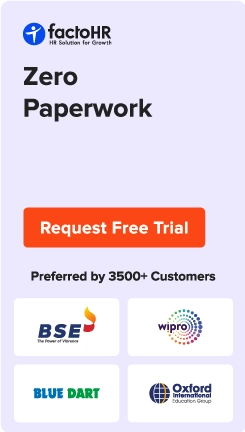Employee Recommendation Letter | Format, Sample

Download Employee Recommendation Letter Word Format For Free
Table of Contents
Managers often have to write a reference letter generally for an employee that has worked with the organization and is going to leave. At the time of a job search, it is helpful for employees to land a new position when they have an endorsement from their previous employer.
Besides this, if you can’t honestly and strongly recommend a particular employee for the position, or if your company does not have a policy of giving recommendations, you can politely turn down their request for reference.
If your organization has the policy to recommend employees, then it’s essential to write it appropriately. If you are new to this here, we have got you covered. In this blog, we will mention the meaning of a recommendation letter with a recommendation letter format and sample.
Meaning of Employee Recommendation Letter
An employee recommendation letter, also known as a letter of reference, recommendation letter, or employee reference letter, is a letter that an employer writes to recommend a former employee mentioning their qualities and skills. The letter positively deems the candidate as ideal for the job. Therefore, recommendation letters are typically helpful for employees looking for a new job as they can share them with different hiring managers and get their dream jobs.
Things to Include in an Employee Recommendation Letter
When crafting an employee recommendation letter, it is important to include specific details and provide a comprehensive overview of the employee’s qualifications and achievements. Here are some key elements to include in the letter:
Introduction and Context
Begin by introducing yourself and your position in the company. Clearly state your relationship with the employee and the duration of your professional association. This sets the foundation for your recommendation and establishes your credibility.
Job Performance and Achievements
Highlight the employee’s job performance and significant achievements. Discuss specific projects they have successfully completed, targets they have surpassed, or any awards they have received. Use performance metrics whenever possible to demonstrate their impact and excellence.
Skills and Qualities
Emphasize the employee’s key skills and qualities that are relevant to the position or opportunity they are seeking. This can include their ability to work well in teams, problem-solving skills, adaptability, leadership abilities, employee relations and communication skills. Provide examples or anecdotes that illustrate these qualities in action.
Work Ethic and Reliability
Mention the employee’s strong work ethic and reliability. Highlight their punctuality, dedication, and commitment to meeting deadlines. Discuss their willingness to go above and beyond to deliver high-quality work consistently.
Personal Attributes
If applicable, include any personal attributes that contribute to the employee’s success. This can include their positive attitude, resilience in the face of challenges, creativity, or ability to handle pressure. These qualities can provide additional insight into their character and potential.
Teamwork and Collaboration
Discuss the employee’s ability to work collaboratively with others. Mention instances where they have successfully contributed to team projects, demonstrated strong interpersonal skills, and fostered a positive and inclusive work environment.
Leadership Potential
If the employee has shown leadership potential, highlight their ability to take initiative, inspire others, and effectively guide teams. Provide examples of their leadership roles or instances where they have demonstrated leadership qualities.
Growth and Development
Discuss the employee’s growth and development during their tenure. Mention any professional development opportunities they have pursued, courses they have taken, or new skills they have acquired. This demonstrates their commitment to continuous learning and improvement.
Conclusion and Recommendation
In the conclusion of the letter, reiterate your strong recommendation for the employee. Summarize their qualifications, achievements, and strengths. Express confidence in their ability to excel in future endeavors.
By including these key elements in your employee recommendation letter, you can provide a well-rounded and compelling endorsement that highlights the employee’s suitability for the desired role or opportunity.

How to Write Employee Recommendation Letter
Here are the three points to keep in mind while preparing the recommendation letter format:
Include all Specifics
Whenever you need to write a recommendation letter for a former employee, ask them to provide you with the information which helps you to make the letter more specific and complete. When an employee works for your organization for a while, they may have acquired new skills meanwhile. So you should ask the employees to provide their updated resume that mentions everything.
Mentioning the dates is also important as it confirms the duration they have worked with the organization. Also, you can ask the employee what type of job they will be applying for in the future so that you can add the information in the letter which is more specific and in its regard. Even you need to ask employees in case when they need some specific names in the letter to be included such as the manager’s name.
Correct Format
The format of the letter should be formal and professional. Begin with the contact information and along mention the date and the contact details of the HR professional. After that, include the salutation and start writing the body of the letter, where it should begin with what are the capacities of the candidate and since how long you know them. Further, you can elaborate about the candidates’ skills, strengths, and experiences which make them stand different and exceptional from others. If the employee has earned specific achievements during their tenure, also highlight them.
The closing statements should show your confidence in the former employee and provide a strong recommendation for them. In the ending also include that you are available to answer any queries and will provide clarification for any of their questions.
If needed Send an Email
In some cases employees can ask for an email to their potential employer. In that scenario follow all the same format used for the letter and just exclude the address part. In the subject of the email write the person’s name and the position they have applied for. For example, Subject: Janhavi Shah – Reference for Business Development Executive.

Employee Recommendation Letter Format
Here is a recommendation letter format that is written by the employer for a former employee. It consists of the employees’ information such as their qualities and attributes on the job along with a strong recommendation for future jobs.

Conclusion
In conclusion, employee recommendation letters play a crucial role in enhancing an individual’s chances of securing their dream job or academic opportunity. A well-crafted letter, providing specific examples of the candidate’s strengths and achievements, can leave a lasting impression on potential employers. Remember to approach the right individuals for recommendations and be sincere in your request. If you are struggling at writing, storing and presenting HR letters to the employees then use our automated HR software to solve all your problems

Download Our Resource
FAQs
1. What to do When you are Preparing a Reference Letter for an Employee?
When preparing a reference letter for an employee, gather relevant information about the employee, establish your relationship with them, use a formal format, and provide a brief introduction. Focus on highlighting the employee’s strengths, skills, and accomplishments with specific examples, and address the requirements of the job they are applying for. Keep the letter positive, concise, and personalized for the specific opportunity. Conclude with a strong endorsement, offer contact information for further inquiries, and always seek the employee’s consent before writing the letter. Thoroughly proofread the letter before finalization to ensure accuracy and professionalism.
2. Are any specific instructions that need to be added in reference letters?
Many times the letter has many requirements to fulfill before submitting it. It could mean that the letter is part of the application process and is essential to provide. There might be requirements to create a digital letter instead of a physical one. Another requirement might be to include the name of the manager and their contact details. The best way to properly write reference letters is to know all the requirements of the former employee.
3. Can a Recommendation Letter be Handwritten?
Yes, a recommendation letter can be handwritten. In some cases, a handwritten letter adds a personal touch and authenticity to the recommendation. However, it’s essential to ensure that the handwriting is neat and legible, as a messy letter may not leave a positive impression on the recipient. Alternatively, typed recommendation letters are also widely accepted and often preferred in professional settings due to their readability and formality. The choice between a handwritten and typed letter depends on the context and the preferences of the person writing the letter and the recipient.
4. Is it Necessary to Mention Weaknesses in the Employee Recommendation letter?
No, it is not necessary to mention weaknesses in an employee recommendation letter. The primary purpose of a recommendation letter is to highlight the candidate’s strengths, skills, and positive qualities that make them a suitable fit for the desired position. The goal is to present the candidate in the best possible light and showcase their capabilities to potential employers or academic institutions.
5. How Long Should an Employee Recommendation Letter be?
An employee recommendation letter typically ranges from one to two pages in length. It should be long enough to provide sufficient detail and specific examples that highlight the candidate’s qualifications, skills, and achievements. However, it’s essential to keep the letter concise and focused on the most relevant information. Avoid unnecessary repetition and tangents, and instead, concentrate on showcasing the employee’s strengths and suitability for the desired position. A well-structured, one to two-page recommendation letter can effectively convey the recommender’s endorsement and leave a positive impression on potential employers or academic institutions.

Modernize your HR tasks with factoHR today
Experience the digitalization of everyday business activities with factoHR's modern and compatible solutions for every need.

© 2024 Copyright factoHR

